OLD SCHOOL
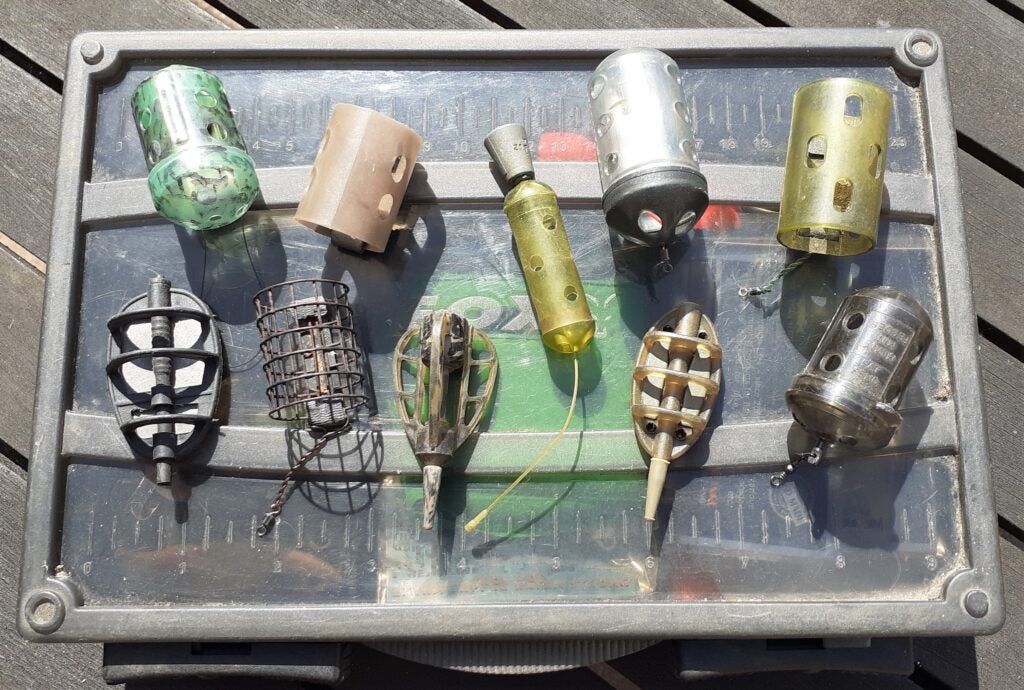

Many of my favourite old feeders suddenly look dated, but I can’t bring myself to throw them away because they hold so many fond memories. A few survivors are still available in tackle shops, such as famous Kamasan Black Cap blockends. Other ground-breaking models are no longer made. Drennan Feeder Links are a good example, which featured interchangeable base weights – a brilliant innovation. Thamesly Blockends cleverly metamorphosized into open-end feeders, which was another smart concept. Early wire cage feeders were a further game changer, releasing their contents in surprisingly versatile ways. Some of these concepts have been subtly updated, but modern innovations have been gathering pace, opening up a wealth of interesting new possibilities. Method feeders started the revolution, when inventive anglers converted frame feeders into elasticated balls of groundbait, with hook baits craftily hidden inside…
METHOD MANIA
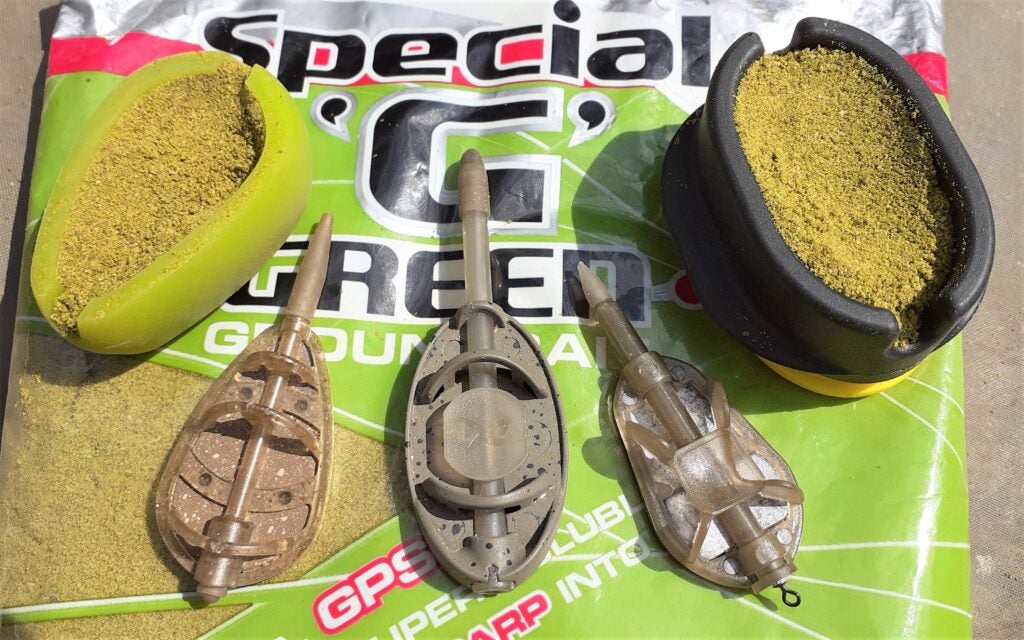

Some said it was crude, but suddenly the method was a game changer. This set-up caught loads of fish, emptying carp puddles and even more surprisingly, catching specimen-sized bream and tench from notoriously hard venues. The fishing tackle industry took note, the race was on, and everyone began churning out method feeders, resulting in many of today’s highly advanced in-line models. Flatbeds have become most popular, thanks to providing such precise bait presentation, combined with custom moulds that form streamlined loadings. Match anglers have fully encompassed using moulds with flatbeds. It’s a fast and precise system, allowing hook baits to be buried or left visible, while creating perfectly formed loadings of groundbait or pellets every time. Such a fast turnaround, getting a primed feeder back into the taking zone, translates into catching more fish. The method is a great leveller too, giving all anglers the chance to be a winner.
GRUB REVIVAL
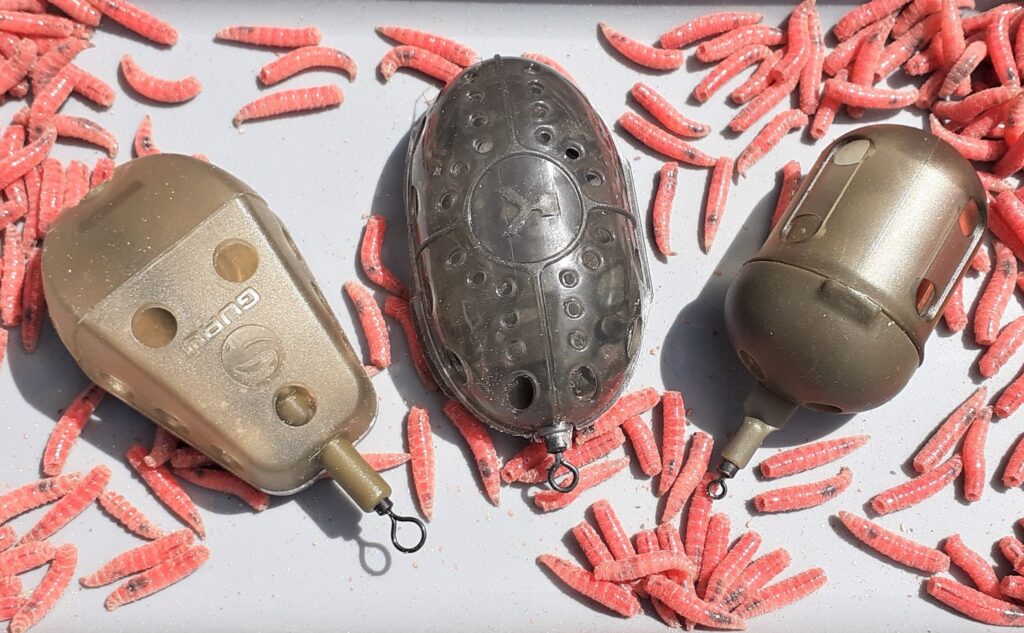

The humble blockend feeder is still widely used for feeding neat maggots, currently making a strong comeback after taking a back seat to pellet-orientated designs. Maggot fishing is key again in two main areas, continuing to be a winning river tactic for chub and barbel, also a worthwhile back-up method for catching carp when pellets aren’t doing the business. The latest grub feeders have striven to incorporate a neater hinged opening, with positive clip-on lids, to make sure loadings get where they are intended to go. They have become noticeably more streamlined, in most cases, offering a better span of side weight options. The latter go heavier, avoiding having to strap on extra lumps of lead. I’ve used modern maggot feeders, but have to say the Kamasan Black Cap is still my favourite. I find it empties its contents out quicker than most, particularly noticeable when incorporated into helicopter rigs, for targeting big stillwater roach.
PELLET PUSHING
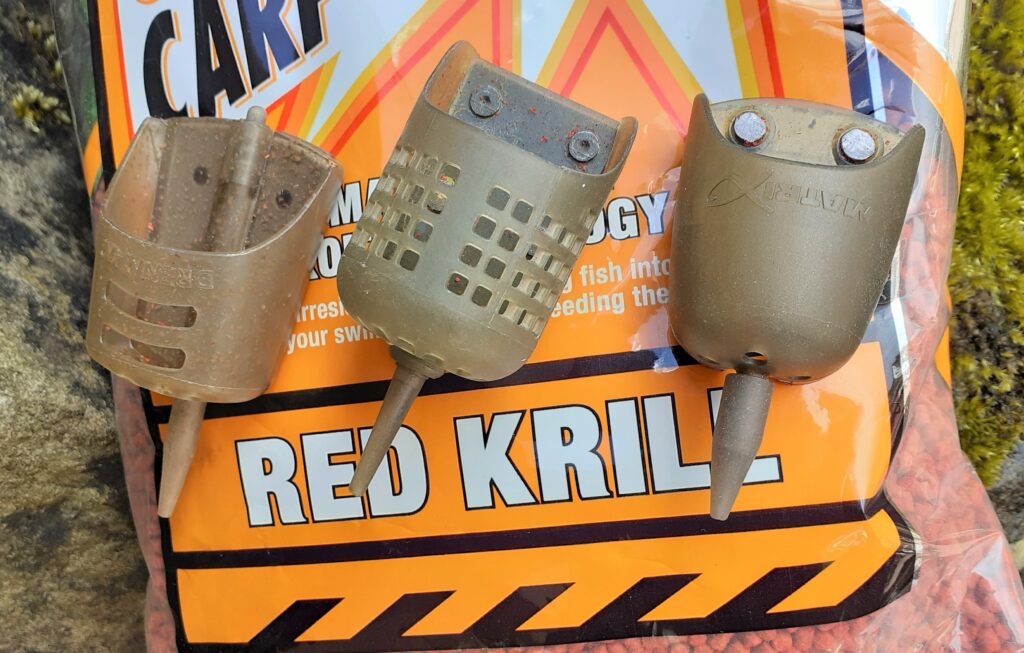

Shovel-shaped pellet feeders are a by-product of the method category. With a little practice they can be loaded one-handed, scooping a few dampened pellets in first, followed by the hook bait, and then burying it with a secondary helping of pellets. Micro feed pellets work best, combined with a bunch of directly hooked maggots, or a banded 6mm wafter. Hair-rigged sweetcorn and banded hard pellets are worth trying too. It only takes around 30 seconds for buried hook baits to tumble out of most pellet feeder designs, using short 4 inch links formed from strong line. These feeders cast very accurately and their flat bases anchor well on sloping terrain, particularly useful when fishing tight to features like islands and far bank cover. The clever thing with pellet feeders, particularly smaller sizes, is they can be used to tease fish into having a go. They don’t put excess bait into swims, even when cast regularly. A dab of groundbait can work wonders too.
OPEN ENDED
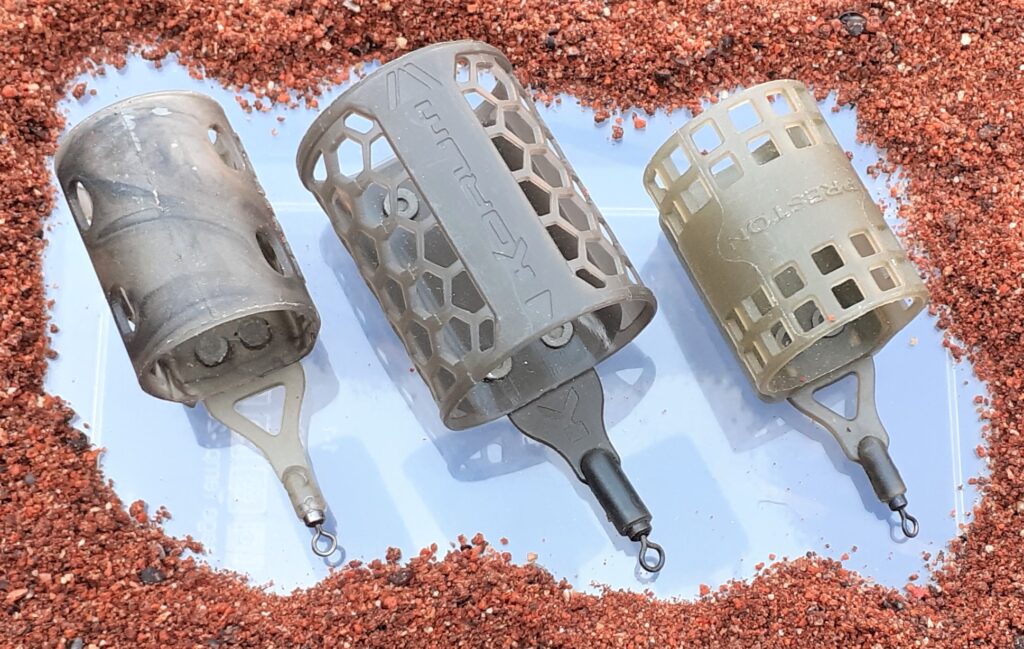

Groundbait or open-end feeders have changed a fair bit, with greater weight options, which go much heavier than they used to. Side weights are better designed in most cases too, blending in smoothly with the bodies, avoiding awkward steps that cause snagging. Most designs feature rigid plastic links with built-in swivels, useful for preventing tangles, while another top improvement has been camouflaged plastic bodies. Perforations have been given more thought, with interesting variations. Some models feature lower set and elongated side openings, while others have no central holes for a sandwich effect, allowing neat baits like casters, chopped worm or pellets to be trapped between two wedges of groundbait. Some plastic models are almost cage-like, to create faster bait release and reduce resistance in flowing water. Open enders are still very popular with bream anglers on rivers, wider drains and medium to large lakes.
SO SIMPLE
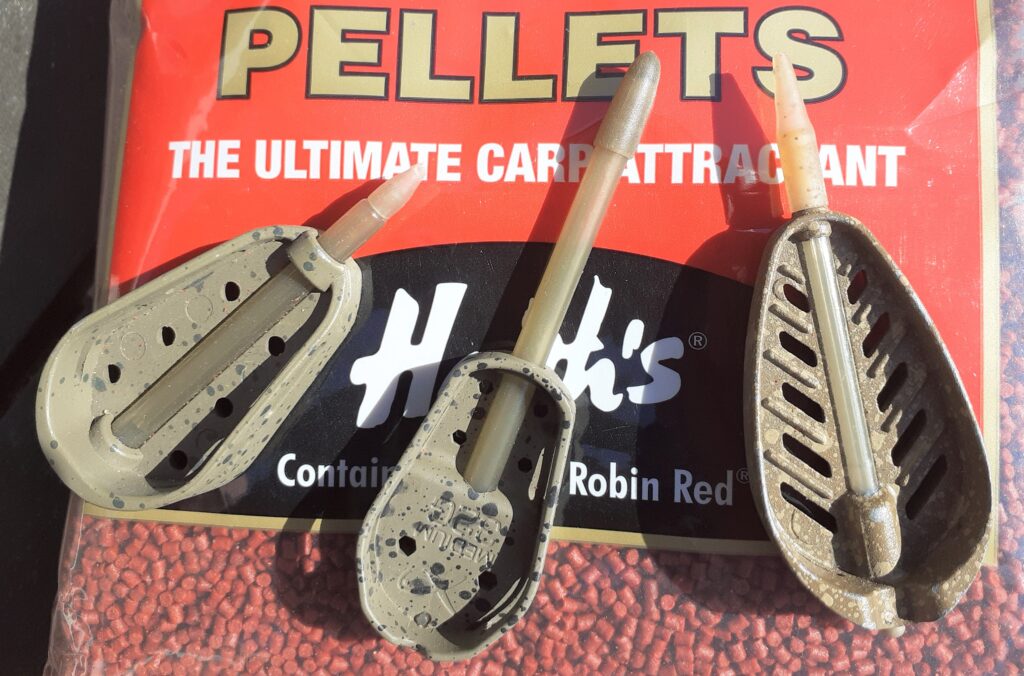

Similar to the way method feeders changed the way a lot of anglers fish, hybrid designs have initiated a brand new trend. These are basically flatbed method feeders without any vanes, just a slightly raised border, which is enough to anchor their loadings. The big advantage is a mould isn’t required to load up these feeders, because this job can be done more quickly by hand. This has appealed to match anglers, making filling and re-casting even faster. These unobtrusive feeders provoke a brilliant response from big fish like carp and bream, particularly at long range. They cast effortlessly to the horizon, working best with pellet loadings, buried baits and short hook links. However, when venues are fishing hard, hybrids can also work wonders with low feed groundbait, carrying just enough grub to provoke a response. Best hook baits tend to be wafters, pellets, sweetcorn, or dead red maggots, presented on short 4 inch links.
BETTER CAGES
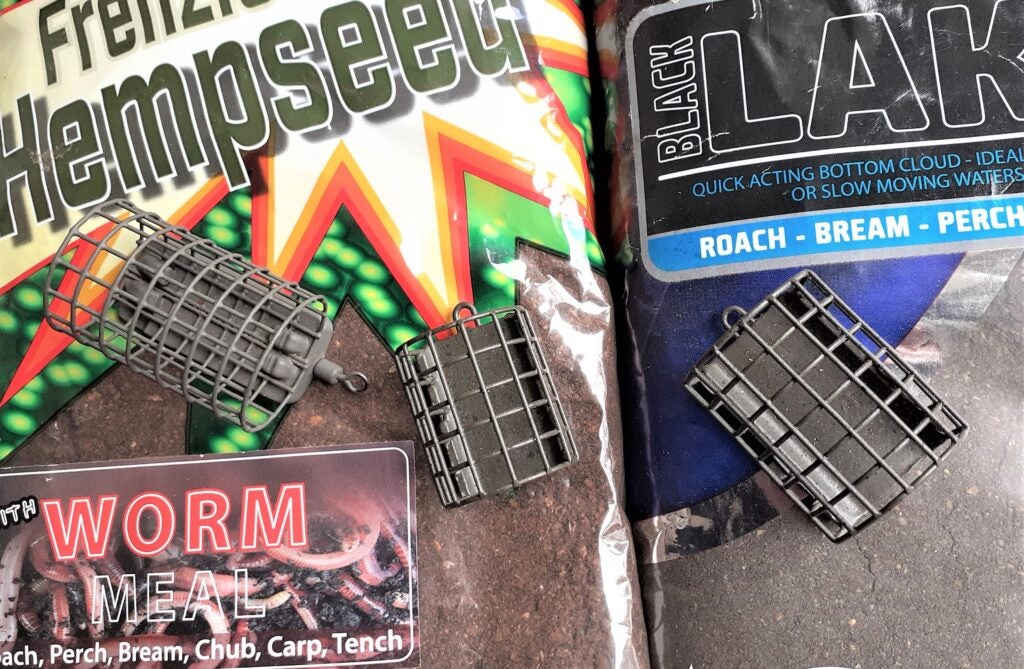

Cage feeders have been around many years. Early designs were made from thin wire mesh, with basic strips of lead and looped mono links. Gradually, sturdier, powder-coated versions have emerged, with neater, more streamlined side leads, in some cases actually moulded onto their wire bodies. Modern versions cast more accurately and are less snag-prone, also blending in better with bottom terrain. Later designs don’t tend to have any booms or links, just wire loops or swivels. These suit currently popular clip-on fluorocarbon feeder links, which create free-running paternoster-style rigs. Using these flexible links makes filling easier and is better than stiff booms, which get in the way. The big advantage with cage feeders is they can produce a wide variety of effects, from getting heavy groundbait mixes hard on the bottom, to producing spectacular clouds of finer feed as they fall and settle. These are the least obtrusive of feeder designs.
SKY ROCKETS
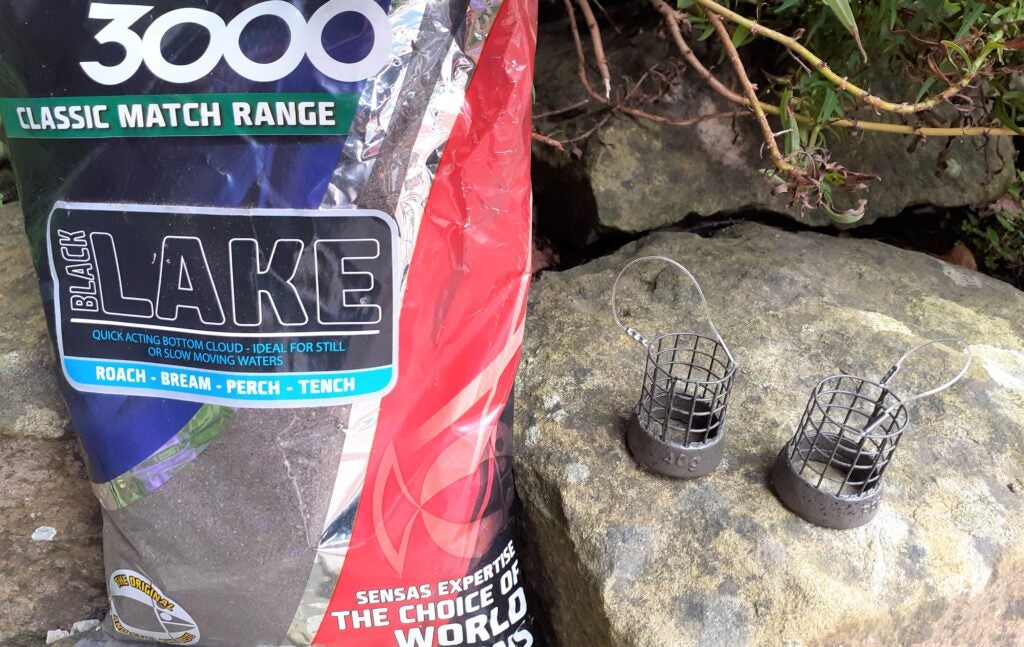

Rocket or bullet feeders originally had cage or plastic bodies and pointed base weights. These feeders were designed for long range fishing, but created quite a lot of resistance when winding them back in such a long way. Gradually wire and plastic cage long rangers, with circular base weights, are becoming popular. These designs are easier to load up and create very little resistance on the retrieve. It’s not unusual for competent feeder anglers to fish distances well in excess of 70 metres these days, thanks to more powerful feeder rods, big pit-style reels and super-thin braided lines. While distance feeders can be used in their own right, generally feeder anglers are now spodding out bait in similar fashion to carp anglers, using beefy rods similar to beachcasters, combined with heavy-duty braid and spombs. Extreme-range feeders normally have base weights ranging from 40g to 100g, capable of achieving some mighty casts.
NEW WINDOWS
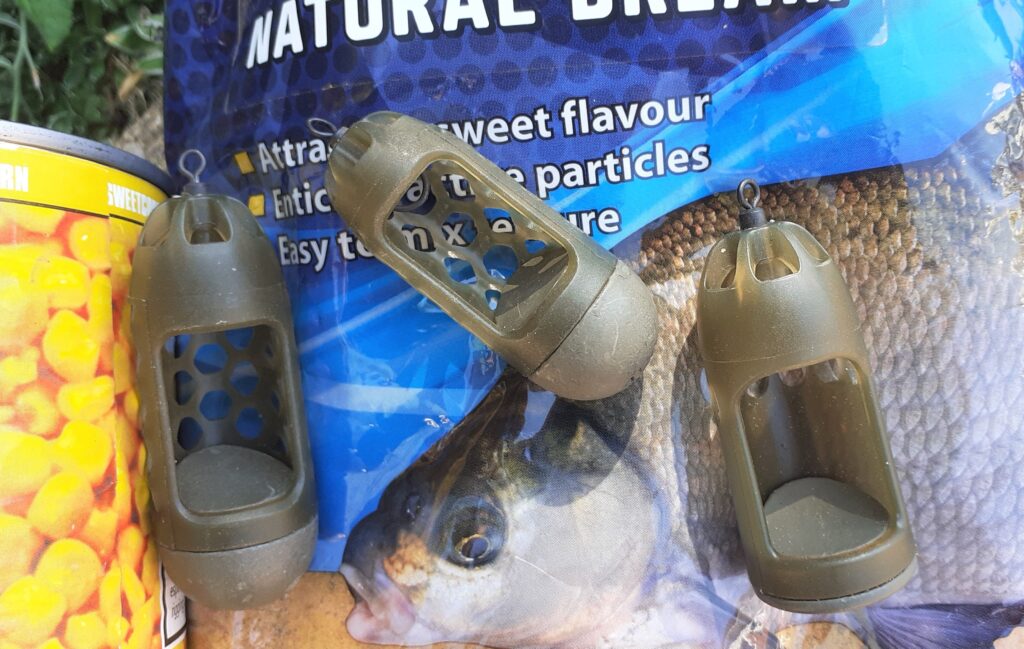

Although the window feeder concept has been around for many years, recent designs from Preston Innovations have really caught the imagination. These offer exceptional long-range casting, with cleverly shaped base leads that have internal slopes, to keep the windows the right way up and make sure bait releases okay. These streamlined feeders are designed to take neat baits like casters, pellets, chopped worm or sweetcorn, held in with just a dab of groundbait. They are mostly used for bream, tench and hybrids on big, windy stillwaters, casting much better than conventional cage or plastic groundbait models. Base weights range from 20g to a meaty 60g that casts to the horizon. For extreme range, these feeders work best with shorter hook lengths in the region of 35-45cms. Any longer and bites tend not to register, even on stiff quivertips. Window feeders come into their own on larger venues, when the fish are shoaled a long way out.
GETTING SORTED
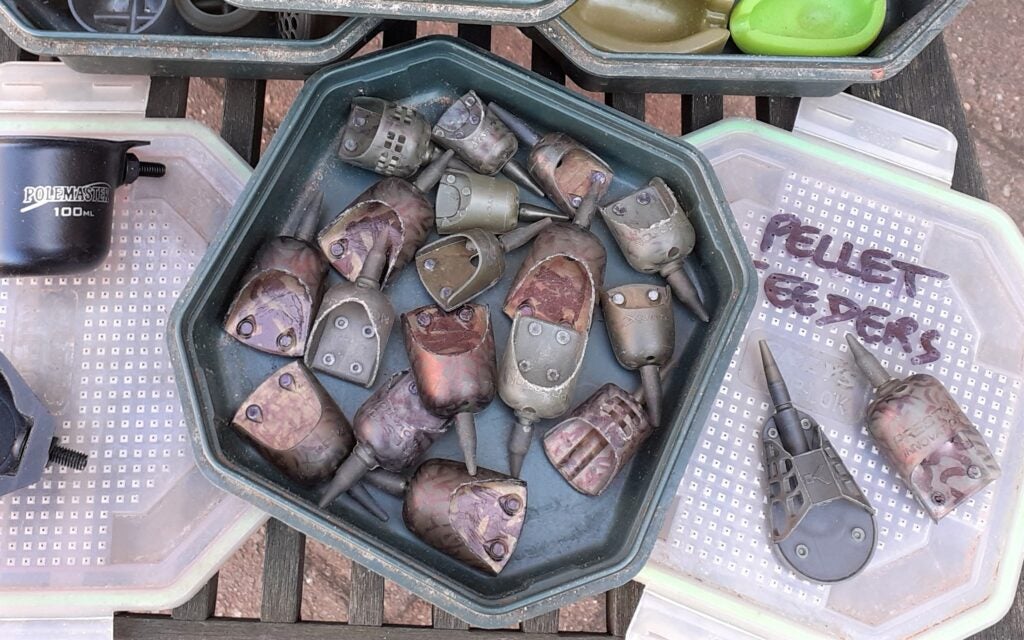

Because there are so many feeder designs to choose from these days, it’s a good idea to categorise your collection into smaller containers, rather than lugging everything around. I like to use two-pint bait boxes for this job, which are big enough to take a good selection of sizes and loadings of the type of feeder required for each session. In this case it’s pellet feeders and as you can see here, I’m not afraid to make modifications. I often dull down all types of swimfeeders with a waterproof black marker pen. I don’t like anything bright that stands out close to my hook bait. In this instance I also open up the back of some pellet feeders even more, which helps the contents and baited hook to spill out even faster. After experimenting in a tub of water, I found micro pellets and the baited hook tumble out in around 30 seconds, which is plenty of time for the feeder to hit bottom. It takes a lot longer to empty the contents with longer body shapes.
BOXING CLEVER
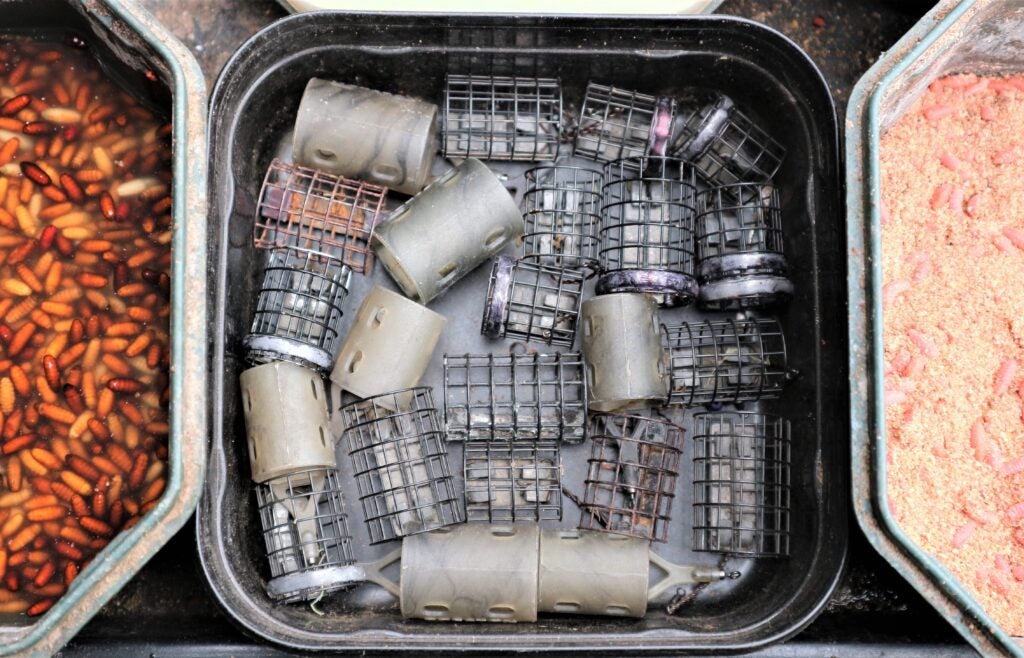

When boxing up swimfeeders for a particular type of species or venue, I sometimes take a mix of designs with me. In this instance cage and plastic bodied open enders. I use cages when I want fast release of their loadings and plastic groundbait feeders when I want to make sure everything gets hard on the bottom, usually in deeper water. In very deep swims I might even tape up the perforations on open end models, so hardy anything comes out on the way down. This is a good trick when using chopped worm, otherwise you can get pestered with small perch for ages. But when using taped feeders, it’s a good idea, after they have been laying on the bottom for a minute or so, to move them in a bit and make sure everything empties out. This leaves the baited hook amongst the groundbait and any freebies, normally encouraging an immediate response. I either use feeder beads or feeder booms on my rigs, which allow quick changes.
MIXING IT
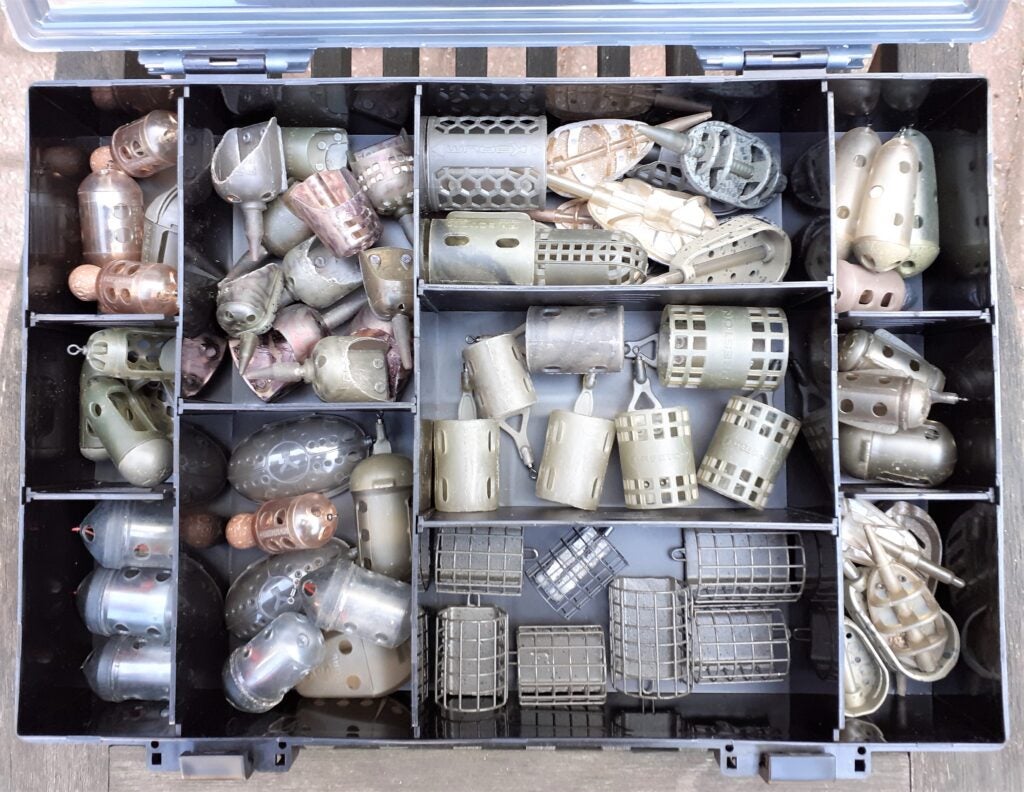

I do have bigger feeder boxes, carrying lots of different designs, for those occasions when I don’t know what the score is likely to be. Large, partitioned boxes are not that expensive, so it’s sensible to have a few of these to store your main swimfeeder collections in. Some companies produce special plastic feeder boxes, even feeder bags to keep all that’s to do with this category together. As mentioned previously, you don’t necessarily have to take the lot with you, but it makes sense to have a base unit which you can use for storage. Having all your feeders in one place makes it easier to find what you want, also allowing you to take everything if you are unsure what’s needed. One thing is for sure, carrying a big number of swimfeeders adds a lot of weight to your kit, so I don’t keep any in my seat box drawers or trays. I like having options of taking exactly what I need, or a sensible mix if a session is likely to require any changes.











